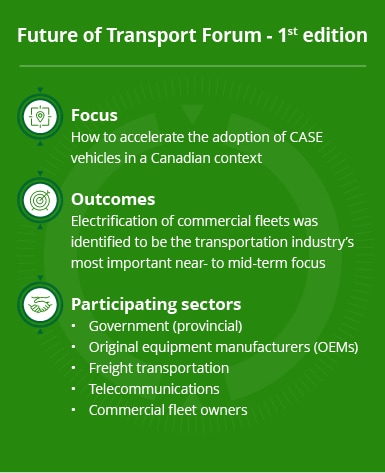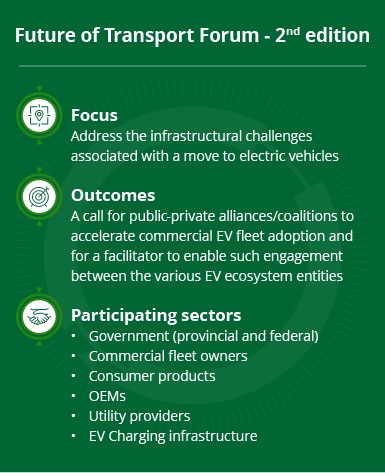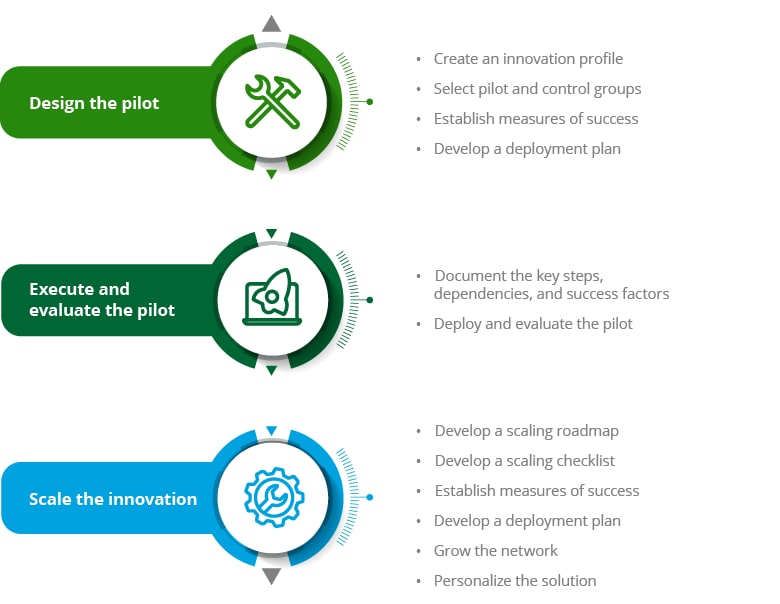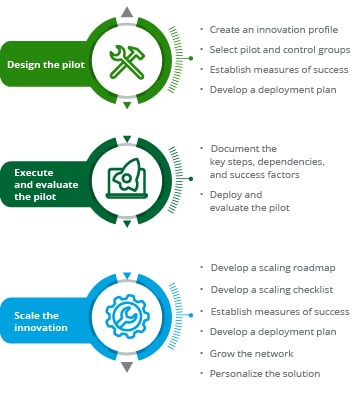Article

Accelerating toward greener commercial transportation
Fleet decarbonization is an essential step for many organizations as they seek to achieve their sustainability goals—and electric vehicles are currently leading the charge.
There’s increasing global focus on a net-zero carbon footprint, shaped by government mandates, incentives, and changing consumer preferences. This is actively disrupting Canada’s transportation sector through the adoption of electric vehicles (EVs) and generating more questions than answers for various public and private entities worldwide. Does the answer to transportation decarbonization lie with electric or hydrogen? Who are the main players that will form the EV ecosystem of the future? What support systems will be critical to enable the smooth transition of fleets with minimal disruption?
To unpack the opportunities, challenges, and risks associated with the expected large-scale transformation of the transportation space, Deloitte Canada developed the Future of Transport Forum initiative in 2022. The objective is to bring the connected, autonomous, shared, and electric (CASE) vehicle ecosystem together in a convenor capacity. In the last 12 months, we have successfully hosted two editions of our Future of Transport Forum, engaging key stakeholders across a variety of industries in a series of collaborative experiences through our Greenhouse Experience Program.
These labs followed a streamlined approach to unlock ideas, capture insights, and chart action plans:


What we learned at the latest Future of Transport Forum
- Canadian fleet owners are approaching fleet decarbonization by prioritizing EVs for last-mile and short/mid-hauls (range of around 200 kilometres) and assessing the feasibility of using hydrogen-powered vehicles for long-haul trips. With advancements in battery technology, EV ranges scale up quickly.
- Organizations have been making progress on their respective fleet electrification journeys, with many participants indicating they are currently in the piloting and scaling phase.
- Significant investments are already under way, and the focus has shifted away from deciding whether to electrify fleets to identifying ways to scale and realize returns on investments.
- Participants were confident that they would be able to accelerate their transition to electrified fleets once key infrastructural challenges and constraints were addressed.
- Most workshop participants were not confident about Canada’s ability to have reliable EV infrastructure in place to help them meet their organizations’ fleet electrification goals by 2030, based on current progress.
How governing bodies are driving fleet decarbonization
In its 2023 federal budget, the Canadian government allocated an impressive $20 billion to the Canadian Infrastructure Bank (CIB) for clean electricity infrastructure and $83 billion in tax credits for clean energy. Further, the Province of British Columbia officially announced an ambitious target of at least 90% EVs for all newly light-duty vehicles by 2030 . Other provincial incentives that have been established for EV purchases and setting up charging infrastructure include Quebec offering up to a $7,000 rebate on a newly purchased/leased EV .
Top challenges to address
- The move to electrified mobility involves many entities (governments, utility providers, fleet owners, OEMs, infrastructure providers, etc.), creating complexities for engagement and a smooth transition. It will therefore be important to identify the key roles, responsibilities, and boundaries of accountability for each entity.
- Private organizations often find it difficult to navigate multiple governmental agencies (at the provincial and federal levels) and utility providers, owing to differences in policies, working styles, or operational capacities. Public entities can enable better public-private collaboration by setting up direct channels and improving engagement.
- Lack of clarity in energy consumption requirements vs. available supply and long lead times for power upgrades can be tackled through transparent communication of expected power requirements between fleet owners and utility providers so that appropriate power management and supply strategies can be drawn up.
- Governments will need to promote more significant investment in setting up electric infrastructure by working closely with utility providers and end-users to understand their future energy supply and demand requirements.
- There’s currently a shortage of skills and relevant capacity for training to support professions created by the EV ecosystem. Governing bodies can capitalize on opportunities to boost the development of EV-specific skills among the workforce by enhancing existing talent and skills development programs and creating new apprenticeship and training avenues.
- Start-ups can reduce capital expenditure for fleet owners by bridging them with EV infrastructure innovatively, such as dedicated multi-user charging facilities outside the fence for fleet owners (i.e. charging vehicles outside an organization’s premises) .
Effort acceleration
Now that specific key challenges and subsequent opportunities have been identified, it’s imperative that Canada increase the momentum gained thus far in the promotion and adoption of EVs. Organizations can further their fleet electrification journeys through a collaborate, pilot, and scale approach by focusing on the core complexities of managing a multitude of EV ecosystem players and constantly changing energy and talent requirements.


Building long-lasting alliances with utility and infrastructure providers, different levels of government, and competitors will be crucial to helping organizations reach the stage where they can conduct a formalized pilot project to use for scaling fleet decarbonization and gathering learnings.
Such a pilot program is a useful way to demonstrate that fleet electrification is an implementable and feasible solution for transportation in Canada. However, instead of going it alone, there’s value in launching a pilot in a smaller sandbox territory or region—for example, a Canadian port, city, corridor, or zone—through a coalition of public and private organizations. The success of such a pilot will depend on the willingness of businesses to invest in vehicles and infrastructure, and the ability of governments to fast-track approvals and establish greater incentives for early adopters.
A successful pilot program will form a use case that stakeholders can leverage to continue building on the transformation brought about by the pilot, which will contribute to further breaking down the barriers to widespread EV adoption. This includes, but is not limited to, ensuring enough power is available to meet future energy demands for charging infrastructure and reducing government red tape.
Once lessons from the pilot program have been gathered, efforts can be made to extend electrification to a wider audience, such as communities, cities, provinces, and eventually across Canada. While each new location will face unique challenges—such as limited connectivity in remote areas, long-haul routes with minimal practical locations for charging, and extreme climate conditions—coalitions and alliances will be vital for sharing information and paving the way to success.
Solid navigation
While the path to large-scale fleet electrification in Canada is complex, smooth navigation depends on key EV ecosystem players and infrastructural constraints being managed in a timely manner. Some considerations:
- There are significant opportunities to enhance EV-specific initiatives and policies, allowing the ecosystem to meet its objectives but, more importantly, for Canada to become a world leader while building a more sustainable transportation sector.
- While we reflected on the potential shortage of skills and labour, Canada has a distinctive advantage with its rate of population growth fuelled by immigration programs that attract young and skilled labour.
- A collaborative ecosystem, driven by private companies and government bodies and agencies, can play the role of a catalyst and foster an environment for adoption, innovation, and scale in fleet electrification.
- Canada can learn from success stories in other geographies and determine how those use cases are relevant, what customizations are required to address unique Canadian needs, and what kinds of coalitions and collaboration are required to bring them to life.
Destination: success
While there’s no doubt about the level of disruption the transportation sector faces, there have already been some important efforts to get it where it needs to be. Still, greater focus is needed to ensure widespread, reliable EV infrastructure, enhance the workforce with EV-specific skills, make progress on sustainability goals, boost engagement, and develop more effective power management and supply strategies. All the players in Canada’s EV ecosystem will need to work together to drive system-wide progress on these vital objectives.
Deloitte Canada is committed to being the convenor of an innovative EV ecosystem to actively shape the future of transport in Canada. This initiative is a manifestation of our firm’s Purpose: to make an impact that matters.
Let’s talk:
Damu Prabhu
Partner, Cyber and Strategic Risk
daprabhu@deloitte.ca | LinkedIn
Darren Plested
Partner, Future of Mobility & Transportation
dplested@deloitte.ca | LinkedIn
Stephen Meagher
Director, OperateNext
smeagher@deloitte.ca | LinkedIn
Seif Kefi
Regional Market Lead, Deloitte Greenhouse
skefi@deloitte.ca | LinkedIn
Recommendations
Electrified fleets pave the way to emissions reduction
Canada’s drive to net-zero is the opportunity to decarbonize commercial vehicles
